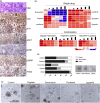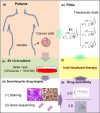Characterization of ascites-derived tumor cells from an endometrial cancer patient
- PMID: 28945304
- PMCID: PMC5715242
- DOI: 10.1111/cas.13407
Characterization of ascites-derived tumor cells from an endometrial cancer patient
Abstract
Improved treatment outcomes for the endometrial cancer patient requires precision methods to investigate the biology of this disease and clinically relevant models to test treatment drugs. Hence, we applied a personalized platform to investigate whether in vitro and in vivo models could accurately predict effective treatment regimens. We successfully expanded ascites-derived tumor cells from an endometrial cancer patient with malignant ascites using ascites collected prior to chemotherapy treatment. Hematoxylin-eosin and immunohistochemistry staining of ascites-derived tumor cells confirmed the source of endometrial cancer cells. Ascites-derived tumor cells were sensitive to cisplatin and doxorubicin single-agent treatments in CCK-8 assay and 3-D culture, a condition that more closely mimics the in vivo environment. We further showed that ascites-derived tumor cells from this patient could form tumors in NOD/SCID mice with preserved morphological characteristics. A remarkable concordance between the clinical response of cisplatin and the results of in vitro and in vivo drug tests reflected the reliability of our personalized approach in this case. Together, our results indicated that an effective platform for ex vivo and in vivo culture of ascites-derived tumor cells from our endometrial cancer patient could be applied to identify treatment options, and may be commonly used in treating cancer patients with malignant ascites in the future.
Keywords: Ascites; drug sensitivity test; endometrial cancer; ex vivo culture; patient-derived xenograft model.
© 2017 The Authors. Cancer Science published by John Wiley & Sons Australia, Ltd on behalf of Japanese Cancer Association.
Figures




Similar articles
-
Clinically relevant inflammatory breast cancer patient-derived xenograft-derived ex vivo model for evaluation of tumor-specific therapies.PLoS One. 2018 May 16;13(5):e0195932. doi: 10.1371/journal.pone.0195932. eCollection 2018. PLoS One. 2018. PMID: 29768500 Free PMC article.
-
Personalized treatment based on mini patient-derived xenografts and WES/RNA sequencing in a patient with metastatic duodenal adenocarcinoma.Cancer Commun (Lond). 2018 Aug 23;38(1):54. doi: 10.1186/s40880-018-0323-y. Cancer Commun (Lond). 2018. PMID: 30139386 Free PMC article.
-
Concentrations of cisplatin and doxorubicin in ascites and peritoneal tumor nodules before and after pressurized intraperitoneal aerosol chemotherapy (PIPAC) in patients with peritoneal metastasis.Eur J Surg Oncol. 2018 Jul;44(7):1112-1117. doi: 10.1016/j.ejso.2018.04.020. Epub 2018 May 4. Eur J Surg Oncol. 2018. PMID: 29753612
-
Humanized NOD-SCID IL2rg–/– mice as a preclinical model for cancer research and its potential use for individualized cancer therapies.Cancer Lett. 2014 Mar 1;344(1):13-19. doi: 10.1016/j.canlet.2013.10.015. Cancer Lett. 2014. PMID: 24513265 Review.
-
Personalized therapy in endometrial cancer: challenges and opportunities.Cancer Biol Ther. 2012 Jan 1;13(1):1-13. doi: 10.4161/cbt.13.1.18438. Epub 2012 Jan 1. Cancer Biol Ther. 2012. PMID: 22198566 Free PMC article. Review.
Cited by
-
Patient-derived xenograft models in hepatopancreatobiliary cancer.Cancer Cell Int. 2022 Jan 28;22(1):41. doi: 10.1186/s12935-022-02454-9. Cancer Cell Int. 2022. PMID: 35090441 Free PMC article. Review.
-
Creation and Validation of Patient-Derived Cancer Model Using Peritoneal and Pleural Effusion in Patients with Advanced Ovarian Cancer: An Early Experience.J Clin Med. 2024 May 6;13(9):2718. doi: 10.3390/jcm13092718. J Clin Med. 2024. PMID: 38731247 Free PMC article.
-
Recent Advancement in Breast Cancer Research: Insights from Model Organisms-Mouse Models to Zebrafish.Cancers (Basel). 2023 May 29;15(11):2961. doi: 10.3390/cancers15112961. Cancers (Basel). 2023. PMID: 37296923 Free PMC article. Review.
-
Capturing tumour heterogeneity in pre- and post-chemotherapy colorectal cancer ascites-derived cells using single-cell RNA-sequencing.Biosci Rep. 2021 Dec 22;41(12):BSR20212093. doi: 10.1042/BSR20212093. Biosci Rep. 2021. PMID: 34708245 Free PMC article.
-
Establishment and characterization of breast cancer organoids from a patient with mammary Paget's disease.Cancer Cell Int. 2020 Aug 3;20:365. doi: 10.1186/s12935-020-01459-6. eCollection 2020. Cancer Cell Int. 2020. PMID: 32774159 Free PMC article.
References
-
- Chen W, Zheng R, Baade PD et al Cancer statistics in China, 2015. CA Cancer J Clin 2016; 66: 115–32. - PubMed
-
- de Jonge MM, Mooyaart AL, Vreeswijk MP et al Linking uterine serous carcinoma to BRCA1/2‐associated cancer syndrome: a meta‐analysis and case report. Eur J Cancer 2017; 72: 215–25. - PubMed
-
- Hodgkinson CL, Morrow CJ, Li Y et al Tumorigenicity and genetic profiling of circulating tumor cells in small‐cell lung cancer. Nat Med 2014; 20: 897–903. - PubMed
Publication types
MeSH terms
Substances
LinkOut - more resources
Full Text Sources
Other Literature Sources

